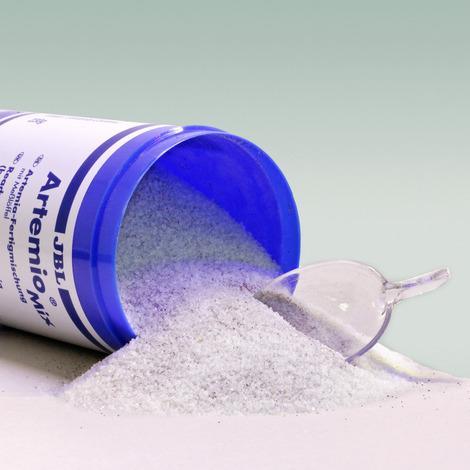
JBL ArtemioMix 200ml (Brine Shrimp Eggs Premix w/ Salt)
Mix of Artemia eggs and salt for mixing
- Live food for tropical freshwater and marine fish.
- Mixed food comprised of brine shrimp eggs, salt and micro algae for the diet of aquarium fish.
- To use: add 3 measuring spoons of the mix to 500ml tap water. The brine shrimps hatch after 24 to 36 hours.
- Optimal pH value thanks to balanced proportion of salt.
- 230 g ready mix for 14 applications, each of 500ml water.
- Package contents: ArtemioMix, ready mix of salt and brine shrimp eggs, incl. measuring spoon 5ml.
Fish love a varied diet
- An unbalanced fish diet can lead In the long term to deficiency symptoms, diseases and fatty degeneration of organs. Provide your aquarium dwellers with a varied died in the form of live food. When catching or purchasing live food there is a risk of introducing bacteria and parasites into the aquarium.
Producing your own live food has many advantages:
- Free of parasites
- Rich in fibre
- Not just a "pool“ anymore
- Promotes the hunting instinct of the fish
- Increases readiness of spawning
- Easy, quick and convenient
- Affordable alternative compared to frozen food
It’s fun to do it yourself :
- Add salt to the water
- Put the Artemia eggs into the saltwater
- Wait until the brine shrimps have hatched
- Strain the brine shrimps into a sieve
- Ready for feeding
ANALYTICAL COMPONENTS
- Crude protein (3.1%)
- Crude fat (0.6%)
- Crude fibre (0.2%)
- Crude ash (0.4%)
FAQ
JBL Artemio Mix: There are only very few nauplius larvae, or none at all, hatching in my tank. What am I doing wrong?
> A water temperature of 25 °C is ideal for hatching. At room temperature (equivalent to a water temperature of approx. 20-21 °C), it takes up to 36 hours. Try again with 2 instead of 3 spoonfuls of the fermentation starter and reduce the air supply to approx. 50%. On condition that the best-before date has not been exceeded, this should work. An additional lighting source at the start of fermentation can considerably increase the hatching rate.
With reference to the KidsSet: the number of eggs in the KidSet in the salt mixture has been reduced (so that the hatched larvae don't poison themselves with their metabolic end products), and this means that you may not be able to recognise the small nauplii in the KidSet at first sight. Backlight may help to see them better.
Planktonic algae are ideal for rearing the larvae. ArtemioFluid contains a suspension of ultra-fine algae products which the larvae accept as substitute food. A warm, light spot is recommended. If there is a lack of light, especially in the winter, you may want to provide additional lighting, e.g. by using an energy-saving lamp.
How high is the hatching rate of the artemia eggs?
> Based on my experience, the actual hatching rate is quite constant within the range of room temperatures, around 90 % for our eggs. The time varies enormously, ranging from 16 h at a temperature of 28 °C to 36 h at 20-21 °C. It isn't until temperatures drop below 20 °C that the hatching rate also drops, and rather quickly at that. Results are best at approx. 25 °C.
The hatching rate depends less on temperature and more so on the eggs used and their origin, where there are distinct differences in terms of both species and years. In some years, the hatching rate is higher, and in others it's somewhat lower.


